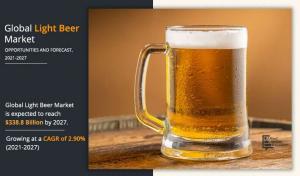Light Beer Market
Light Beer Market Set to Reach $338.8B by 2027: New Report @allied_MR
— Allied Market Research
WILMINGTON,NEW CASTLE, DELAWARE, UNITED STATES, April 24, 2024 /EINPresswire.com/ — According to a new report published by Allied Market Research, titled “Light Beer Market by Production, Package, and Distribution Channel: Opportunity Analysis and Industry Forecast, 2021–2027, the light beer market size was valued at $285.3billion in 2019 and is expected to garner $338.8 billion by 2027, registering a CAGR of 2.9% from 2021 to 2027.
▶️ 𝐑𝐞𝐪𝐮𝐞𝐬𝐭 𝐒𝐚𝐦𝐩𝐥𝐞 𝐂𝐨𝐩𝐲 𝐨𝐟 𝐓𝐡𝐢𝐬 𝐑𝐞𝐩𝐨𝐫𝐭
Beer is one of the most widely consumed alcoholic beverages in the world. light beer market is prepared using malted cereals, hops, and water. Factors such as cultural changes and penetration of western culture have influenced consumers’ behavior and inclination toward light beer beverages. Light beer companies have recently introduced various flavors, targeting the female audience. Moreover, changing social lifestyle of the working class and growing disposable income, especially in developing Asian economies, have fueled market growth.
increase in young population and number of female drinkers directly drive the beer market. Female drinking is being accepted socially, as a greater number of females are getting at par with men both socially and professionally. increase in disposable income of people allows them to consume high-quality, premium beer and not just traditional beer and rum. The increase in the number of restaurants and bars have resulted in greater consumption of these beverages, as people increasingly prefer on-premise drinking to off-premise drinking. Brewers and distributors across the globe strive to appeal millennials, who are known for their binge drinking habits.
Barriers to entry in this industry are high and steady. These restrictions include reduced costs and other high ongoing capital requirements, such as capital costs of manufacturing facilities and branding. Major companies have pre-existing agreements with distributors, which are heavily regulated and limited on a regional basis, severely limiting the exposure available to new players. In addition, shelf space is limited in retail outlets and major players produce a wide variety of products, which prevent many new players from placing their products in certain stores.
On the basis of production, the craft brewery segment accounted for the maximum light beer market share in 2019. This is attributed to increase in production volume of craft beer in America by 5% in the first two quarters of 2017, but it was slightly less than the growth achieved in the middle of 2016. According to the Chief Economist of the Brewers Association, the growth rate for small craft brewers has been estimated to be progressive in coming five years in the mature beer market. The number of craft breweries in the U.S. and Europe accounted for 86% of total craft breweries globally. This was mainly due to the growing consumer preference for craft beer.
On the basis of package, the pet bottle segment accounted for the maximum light beer market share in 2019. This is attributed to the fact that various beer manufacturers have started switching from glass bottles to PET packaging owing to its superior physical properties such as high design flexibility, lightweight, and recyclability. PET bottles are up to 86% lighter as compared to its glass counterpart, which is expected to significantly improve supply chain performance, thereby reducing packaging-related production cost. Moreover, PET bottles provide high impermeability to gases and, thus, provide high resistance to oxygen uptake and carbon dioxide loss, thereby providing a shelf life up to six months
▶️ 𝐆𝐞𝐭 𝐑𝐞𝐩𝐨𝐫𝐭 𝐂𝐮𝐬𝐭𝐨𝐦𝐢𝐳𝐚𝐭𝐢𝐨𝐧
On the basis of distribution channel, the hypermarkets and supermarkets segment accounted for the maximum light beer market share in 2019. This is attributed to the availability of a broad range of consumer goods under a single roof, ample parking space, and convenient operation timing. Moreover, increase in urbanization, rise in working-class population, and competitive pricing boost the popularity of hypermarkets in developed and developing regions.
𝐌𝐚𝐫𝐤𝐞𝐭 𝐃𝐫𝐢𝐯𝐞𝐫𝐬: 𝐂𝐡𝐚𝐧𝐠𝐢𝐧𝐠 𝐂𝐨𝐧𝐬𝐮𝐦𝐞𝐫 𝐏𝐫𝐞𝐟𝐞𝐫𝐞𝐧𝐜𝐞𝐬
Rapid urbanization and improved financial conditions in many countries worldwide have significantly boosted disposable incomes. Consequently, consumer preferences, particularly among young, aspirational drinkers in developed economies like Europe and North America, are shifting towards modern and different beer varieties over traditional options like rum. There’s a noticeable trend towards healthier alcoholic beverages, such as light beer, due to their lower calorie and alcohol content, reflecting an increasing inclination towards health-conscious choices.
𝐌𝐚𝐫𝐤𝐞𝐭 𝐃𝐫𝐢𝐯𝐞𝐫𝐬: 𝐈𝐧𝐜𝐫𝐞𝐚𝐬𝐞 𝐢𝐧 𝐎𝐧-𝐏𝐫𝐞𝐦𝐢𝐬𝐞 𝐃𝐢𝐬𝐭𝐫𝐢𝐛𝐮𝐭𝐢𝐨𝐧 𝐂𝐡𝐚𝐧𝐧𝐞𝐥𝐬
The global light beer market is heavily driven by the expansion of on-premise distribution channels, including restaurants, cafes, discos, and bars. These venues offer a variety of beer options, including special cocktails containing light beer. With the rise in disposable income and evolving consumer preferences, there’s been a notable surge in demand for on-premise consumption. The growing number of restaurants and bars further fuels this trend, as consumers increasingly prefer enjoying beverages in on-premise settings rather than opting for off-premise consumption.
𝐌𝐚𝐫𝐤𝐞𝐭 𝐑𝐞𝐬𝐭𝐫𝐚𝐢𝐧𝐭: 𝐕𝐨𝐥𝐚𝐭𝐢𝐥𝐞 𝐑𝐚𝐰 𝐌𝐚𝐭𝐞𝐫𝐢𝐚𝐥 𝐏𝐫𝐢𝐜𝐞𝐬
One significant restraint affecting the beer market is the volatility of raw material prices. The production of these beverages relies on crops, which are susceptible to price fluctuations due to factors like droughts and environmental issues. This volatility creates a supply-demand gap in the industry, leading to reduced production and increased product prices. Consequently, the growth of the market is hindered by these challenges associated with raw material pricing instability.
𝐌𝐚𝐫𝐤𝐞𝐭 𝐎𝐩𝐩𝐨𝐫𝐭𝐮𝐧𝐢𝐭𝐢𝐞𝐬: 𝐃𝐞𝐯𝐞𝐥𝐨𝐩𝐦𝐞𝐧𝐭 𝐨𝐟 𝐍𝐚𝐭𝐮𝐫𝐚𝐥𝐥𝐲 𝐒𝐰𝐞𝐞𝐭𝐞𝐧𝐞𝐝, 𝐇𝐞𝐚𝐥𝐭𝐡𝐢𝐞𝐫 𝐀𝐥𝐜𝐨𝐡𝐨𝐥𝐢𝐜 𝐃𝐫𝐢𝐧𝐤𝐬
Innovations in honey-derived products present promising opportunities for the alcoholic beverage industry’s future growth. Fermented honey-based drinks offer a natural and healthier alternative, driving consumer interest and market expansion. Various innovative products, such as sherry-type wines, fruit-honey wines, and different types of meads, are emerging in response to this trend. Manufacturers are launching these products in a range of flavors, utilizing different floral sources of honey, yeast strains, and additives. For instance, Anheuser-Busch’s introduction of the natural light Naturdays Strawberry Lemonade beer in the U.S. market illustrates efforts to enhance market penetration and cater to evolving consumer preferences.
The outbreak of COVID-19 has severely impacted the global economies and has caused severe disruption in supply chain. Also, the lockdown imposed in various countries across the globe is hampering the production of light beer. Similarly, lockdown has disrupted the supply of end products to retail store, thus negatively impacting light beer market trends.
▶️ 𝐓𝐚𝐥𝐤 𝐭𝐨 𝐨𝐮𝐫 𝐄𝐱𝐩𝐞𝐫𝐭
The global light beer market is segmented into production, package, distribution channel, and region. Based on production, the market is categorized into macro-breweries, micro-breweries, craft breweries, chips, and others. Based on package, the market is categorized into glass, pet bottles, metal cans, and others. Based on the distribution channel, the market is fragmented into hypermarkets & supermarkets, on-trade, specialty stores, convenience stores, and others. Based on region, the market is analyzed across North America, Europe, Asia-Pacific, and LAMEA.
𝐊𝐞𝐲 𝐟𝐢𝐧𝐝𝐢𝐧𝐠𝐬 𝐨𝐟 𝐭𝐡𝐞 𝐬𝐭𝐮𝐝𝐲
𝐎𝐧 𝐭𝐡𝐞 𝐛𝐚𝐬𝐢𝐬 𝐨𝐟 𝐩𝐫𝐨𝐝𝐮𝐜𝐭𝐢𝐨𝐧, 𝐭𝐡𝐞 𝐜𝐫𝐚𝐟𝐭 𝐛𝐫𝐞𝐰𝐞𝐫𝐲 𝐬𝐞𝐠𝐦𝐞𝐧𝐭 𝐰𝐚𝐬 𝐭𝐡𝐞 𝐡𝐢𝐠𝐡𝐞𝐬𝐭 𝐜𝐨𝐧𝐭𝐫𝐢𝐛𝐮𝐭𝐨𝐫 𝐭𝐨 𝐭𝐡𝐞 𝐥𝐢𝐠𝐡𝐭 𝐛𝐞𝐞𝐫 𝐦𝐚𝐫𝐤𝐞𝐭, 𝐚𝐧𝐝 𝐢𝐬 𝐞𝐱𝐩𝐞𝐜𝐭𝐞𝐝 𝐭𝐨 𝐠𝐫𝐨𝐰 𝐚𝐭 𝐚 𝐂𝐀𝐆𝐑 𝐨𝐟 𝟐.𝟑𝟎% 𝐟𝐫𝐨𝐦 𝟐𝟎𝟐𝟏 𝐭𝐨 𝟐𝟎𝟐𝟕.
𝐁𝐲 𝐩𝐚𝐜𝐤𝐚𝐠𝐞, 𝐭𝐡𝐞 𝐏𝐄𝐓 𝐛𝐨𝐭𝐭𝐥𝐞 𝐬𝐞𝐠𝐦𝐞𝐧𝐭 𝐥𝐞𝐝 𝐭𝐡𝐞 𝐦𝐚𝐫𝐤𝐞𝐭 𝐢𝐧 𝐭𝐞𝐫𝐦𝐬 𝐨𝐟 𝐯𝐚𝐥𝐮𝐞 𝐢𝐧 𝟐𝟎𝟏𝟗, 𝐚𝐧𝐝 𝐢𝐬 𝐞𝐬𝐭𝐢𝐦𝐚𝐭𝐞𝐝 𝐭𝐨 𝐠𝐫𝐨𝐰 𝐚𝐭 𝐚 𝐂𝐀𝐆𝐑 𝐨𝐟 𝟐.𝟔𝟎% 𝐟𝐫𝐨𝐦 𝟐𝟎𝟐𝟏𝐭𝐨 𝟐𝟎𝟐𝟕.
𝐃𝐞𝐩𝐞𝐧𝐝𝐢𝐧𝐠 𝐨𝐧 𝐭𝐡𝐞 𝐝𝐢𝐬𝐭𝐫𝐢𝐛𝐮𝐭𝐢𝐨𝐧 𝐜𝐡𝐚𝐧𝐧𝐞𝐥, 𝐭𝐡𝐞 𝐡𝐲𝐩𝐞𝐫𝐦𝐚𝐫𝐤𝐞𝐭𝐬 𝐚𝐧𝐞𝐧𝐭 𝐢𝐬 𝐞𝐱𝐩𝐞𝐜𝐭𝐞𝐝 𝐭𝐨 𝐠𝐫𝐨𝐰 𝐚𝐭 𝐚 𝐬𝐭𝐞𝐚𝐝𝐲 𝐂𝐀𝐆𝐑 𝐨𝐟 𝟐.𝟔𝟎% 𝐟𝐫𝐨𝐦 𝟐𝟎𝟐𝟏𝐭𝐨 𝟐𝟎𝟐𝟕.
𝐑𝐞𝐠𝐢𝐨𝐧 𝐰𝐢𝐬𝐞, 𝐍𝐨𝐫𝐭𝐡 𝐀𝐦𝐞𝐫𝐢𝐜𝐚 𝐢𝐬 𝐞𝐱𝐩𝐞𝐜𝐭𝐞𝐝 𝐭𝐨 𝐠𝐫𝐨𝐰 𝐚𝐭 𝐚 𝐬𝐭𝐞𝐚𝐝𝐲 𝐂𝐀𝐆𝐑 𝐨𝐟 𝟏.𝟗𝟎% 𝐟𝐫𝐨𝐦 𝟐𝟎𝟐𝟏𝐭𝐨 𝟐𝟎𝟐𝟕.
The key players operating in the light beer industry are ABInBev, MillerCoors, Heineken USA, Pabst, Diageo-Guinness, Carlsberg, Asahi Breweries, Suntory Beer, Arpanoosh, and Erdinger Weibbrau.
𝐀𝐛𝐨𝐮𝐭 𝐔𝐬
Allied Market Research (AMR) is a full-service market research and business-consulting wing of Allied Analytics LLP, based in Portland, Oregon. Allied Market Research provides global enterprises as well as medium and small businesses with unmatched quality of “Market Research Reports” and “Business Intelligence Solutions.” AMR has a targeted view of providing business insights and consulting to assist its clients in making strategic business decisions and achieving sustainable growth in their respective market domains.
We have professional corporate relations with various companies, and this helps us dig out market data that helps us generate accurate research data tables and confirms the utmost accuracy in our market forecasting. Allied Market Research CEO Pawan Kumar is instrumental in inspiring and encouraging everyone associated with the company to maintain high-quality data and help clients in every way possible to achieve success. Each and every piece of data presented in the reports published by us is extracted through primary interviews with top officials from leading companies in the domain concerned. Our secondary data procurement methodology includes deep online and offline research and discussion with knowledgeable professionals and analysts in the industry.
David Correa
Allied Market Research
+1 503-894-6022
email us here
Visit us on social media:
Facebook
Twitter
LinkedIn
Other
![]()
Article originally published on www.einpresswire.com as Allied Market Research Forecasts $338.8B by 2027.





